05 April 2015
[Island] Hopping to catch frogs
05/04/15 21:17
April 4, 2015
By Anat M. Belasen
Could islands be key in understanding the enigmatic dynamics of Batrachochytrium dendrobatidis? There are a couple of reasons to think so. First, islands present an opportunity to disentangle complex things, like community structure (they tend to be simpler than the mainland, with fewer host species), disease transmission among sub-populations (they’re usually isolated, especially for amphibians), and anthropogenic disease introductions (again, they’re usually isolated… though not always). Second, because islands, especially small ones, contain small isolated populations, these populations tend to be genetically impoverished because of the combined actions of genetic drift and inbreeding. The presence of these conditions offer a chance to look at how host genetics can mediate disease dynamics. Third, since they’re so isolated, islands might be disease-free! This could be really useful and exciting, especially since Bd seems to be everywhere, limiting our ability to compare control (disease-free) populations to those suffering epidemic declines. This comparison could allow us to identify factors responsible for resistance, and help us understand the hosts’ evolutionary responses to disease.
With these three reasons in mind, our team took to the land-bridge islands off of the northern coast (Litoral Norte) of São Paulo state, which are essentially 10-20,000 year old fragments of the Brazilian Atlantic Rainforest, separated by Quaternary sea level rise following the Last Glacial Maximum. We focused on one species, Thoropa taophora, a Cycloramphid frog that is found on a large proportion of these islands. This species is able to reproduce on rocks covered in a small film of water, making it resilient against harsh island environments, which are more variable and can dry out faster than the mainland.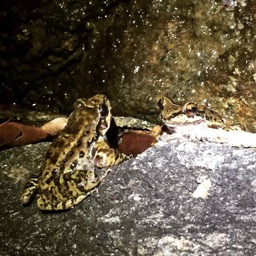 Few pool-breeding species are found on the islands, likely due to this increased level of exposure to the elements. We also sampled every other frog encountered, to maintain a record of the background disease pressure faced by these populations.
Few pool-breeding species are found on the islands, likely due to this increased level of exposure to the elements. We also sampled every other frog encountered, to maintain a record of the background disease pressure faced by these populations.
Right. Two Thoropa taophora congregating on the wet rocks at the Praia do Toque-Toque Grande, SP.
Above. These Thoropa tadpoles undergo complete development to metamorphosis on the wet rock surfaces.
Seven island populations of Thoropa were surveyed, and both skin swab and genetic samples were taken for future analyses. Genetic samples from frogs will allow the analysis of population genetics, to see how impoverished these island populations have become over time. Skin swabs can be used to screen for a number of pathogens, including Bd, Ranaviruses, and other fungi and parasites that can infect amphibians. These data can be used to examine whether populations with lower genetic diversity exhibit higher overall disease susceptibility in the field, and also to test the hypothesis that pathogen communities can also become less complex as hosts lose genetic diversity or as the pathogen community suffers island effects as well. This may be problematic, because lower parasite diversity could release competitive control on more dangerous pathogens like Bd.
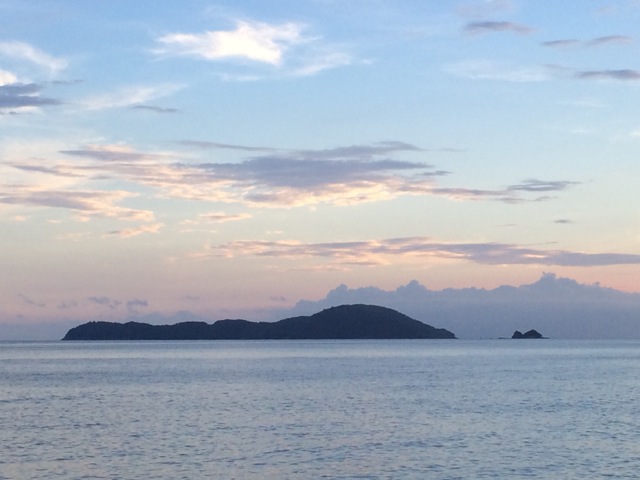
Above. View of Ilha Mar Virado from the beach at Sununga
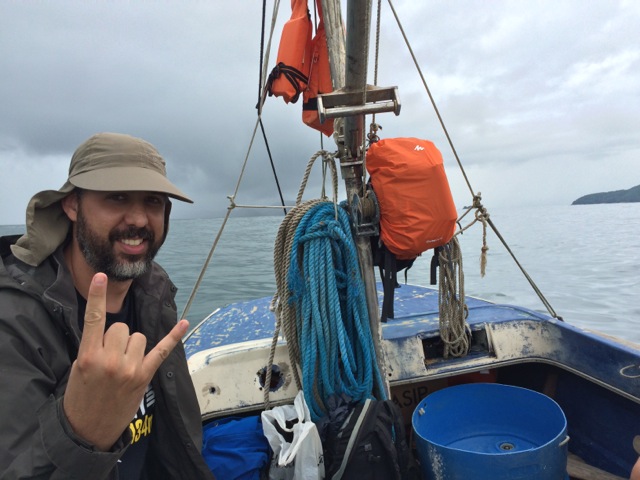
Above. Felipe Toledo on the way to Mar Virado.
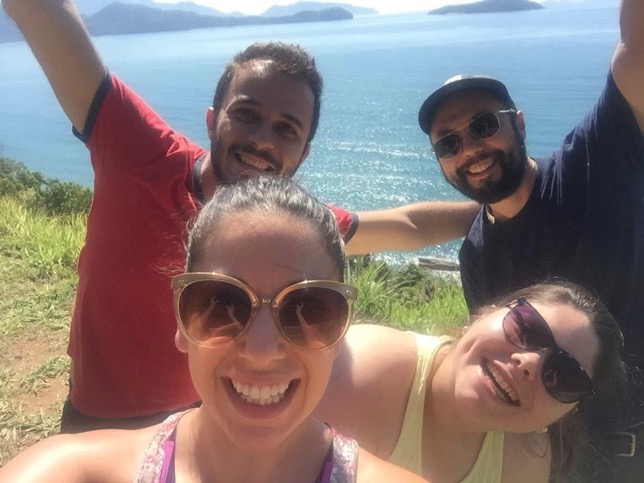
Above. Searching for pirates.
We also surveyed mainland populations to serve as baseline sites, to see what level of genetic diversity T. taophora “normally” harbors. The mainland sites included rocky beaches and sandy caves along the northern São Paulo coast. This fieldwork was pretty different from last year, when we spent most of our time in remote forests. This year we interacted with local people (beachgoers) a bit more. They were often interested in what we were doing, and sometimes they even helped us catch frogs on the beach.
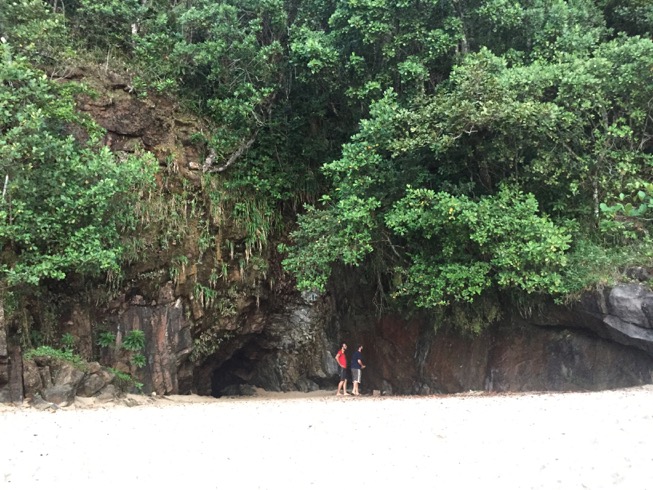
Above. Tsunami and Tim at the Gruta que Chora (Crying Cave) at Sununga Beach.
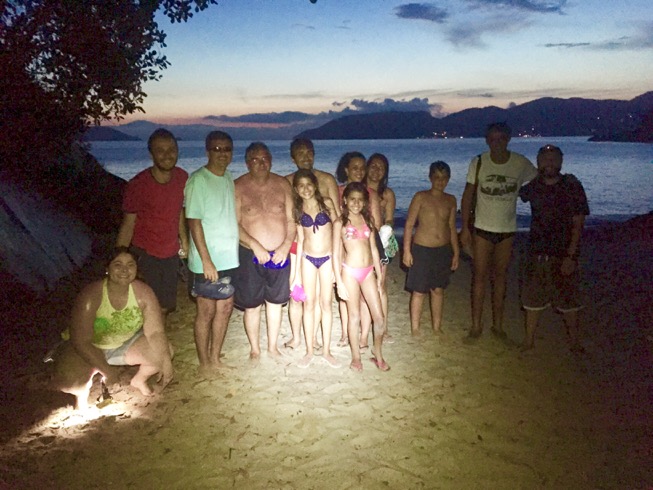
Above. Citizen scientists help catch frogs.
Land-use practices that degrade and fragment habitats cause wildlife populations to become reduced and isolated, much like species living on islands. Through the same processes of genetic drift and inbreeding, these fragmented populations lose genetic diversity. Therefore, a fourth reason to study islands is because they provide us with insights into the effects of the long-term loss of genetic diversity. Therefore, land-bridge island systems may help us understand what current habitat fragmentation may be doing to wildlife in the long run. Now that the samples are collected, the real work begins to piece together the puzzles of disease distribution, genetic diversity, and susceptibility in island frogs of the Brazilian Atlantic Forest.
By Anat M. Belasen
Could islands be key in understanding the enigmatic dynamics of Batrachochytrium dendrobatidis? There are a couple of reasons to think so. First, islands present an opportunity to disentangle complex things, like community structure (they tend to be simpler than the mainland, with fewer host species), disease transmission among sub-populations (they’re usually isolated, especially for amphibians), and anthropogenic disease introductions (again, they’re usually isolated… though not always). Second, because islands, especially small ones, contain small isolated populations, these populations tend to be genetically impoverished because of the combined actions of genetic drift and inbreeding. The presence of these conditions offer a chance to look at how host genetics can mediate disease dynamics. Third, since they’re so isolated, islands might be disease-free! This could be really useful and exciting, especially since Bd seems to be everywhere, limiting our ability to compare control (disease-free) populations to those suffering epidemic declines. This comparison could allow us to identify factors responsible for resistance, and help us understand the hosts’ evolutionary responses to disease.
With these three reasons in mind, our team took to the land-bridge islands off of the northern coast (Litoral Norte) of São Paulo state, which are essentially 10-20,000 year old fragments of the Brazilian Atlantic Rainforest, separated by Quaternary sea level rise following the Last Glacial Maximum. We focused on one species, Thoropa taophora, a Cycloramphid frog that is found on a large proportion of these islands. This species is able to reproduce on rocks covered in a small film of water, making it resilient against harsh island environments, which are more variable and can dry out faster than the mainland.

Right. Two Thoropa taophora congregating on the wet rocks at the Praia do Toque-Toque Grande, SP.
Above. These Thoropa tadpoles undergo complete development to metamorphosis on the wet rock surfaces.
Seven island populations of Thoropa were surveyed, and both skin swab and genetic samples were taken for future analyses. Genetic samples from frogs will allow the analysis of population genetics, to see how impoverished these island populations have become over time. Skin swabs can be used to screen for a number of pathogens, including Bd, Ranaviruses, and other fungi and parasites that can infect amphibians. These data can be used to examine whether populations with lower genetic diversity exhibit higher overall disease susceptibility in the field, and also to test the hypothesis that pathogen communities can also become less complex as hosts lose genetic diversity or as the pathogen community suffers island effects as well. This may be problematic, because lower parasite diversity could release competitive control on more dangerous pathogens like Bd.

Above. View of Ilha Mar Virado from the beach at Sununga

Above. Felipe Toledo on the way to Mar Virado.

Above. Searching for pirates.
We also surveyed mainland populations to serve as baseline sites, to see what level of genetic diversity T. taophora “normally” harbors. The mainland sites included rocky beaches and sandy caves along the northern São Paulo coast. This fieldwork was pretty different from last year, when we spent most of our time in remote forests. This year we interacted with local people (beachgoers) a bit more. They were often interested in what we were doing, and sometimes they even helped us catch frogs on the beach.

Above. Tsunami and Tim at the Gruta que Chora (Crying Cave) at Sununga Beach.

Above. Citizen scientists help catch frogs.
Land-use practices that degrade and fragment habitats cause wildlife populations to become reduced and isolated, much like species living on islands. Through the same processes of genetic drift and inbreeding, these fragmented populations lose genetic diversity. Therefore, a fourth reason to study islands is because they provide us with insights into the effects of the long-term loss of genetic diversity. Therefore, land-bridge island systems may help us understand what current habitat fragmentation may be doing to wildlife in the long run. Now that the samples are collected, the real work begins to piece together the puzzles of disease distribution, genetic diversity, and susceptibility in island frogs of the Brazilian Atlantic Forest.
